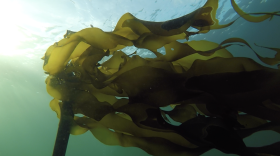Alaska state and local health officials are warning of dangerously high levels of toxins in shellfish, after a person died of paralytic shellfish poisoning from mussels and snails in Unalaska.
"Right now, the levels are high enough that just one mussel could kill someone," said Sarah Spelsberg, a physician assistant at Iliuliuk Family and Health Services.
The state health department announced the death in a prepared statement Wednesday. The person had underlying health conditions that contributed to the death, but the state medical examiner's office confirmed that the primary cause was exposure to the toxins from seafood, the statement said.
This is the first known PSP fatality in Alaska since 2010, although serious illnesses are reported more frequently, the state said. Dating back to 1993, the state has recorded four previous PSP deaths: in 1994, 1997 and two in 2010. There have also been more than 100 non-fatal cases of shellfish poisoning.
The person who died ate the mussels and snails collected from an Unalaska beach July 4. The shellfish were cooked, and the person developed symptoms some four hours after eating.
Blue mussel samples collected from the beach the same day were found to have extremely high toxin levels— more than 100 times higher than the safe limit, the state said. The snail samples also had elevated toxin levels, but not as high as the mussels.
The patient's initial symptoms included tingling fingers, numbness, a floating sensation and vomiting, the state said. Several hours later, the patient reported numbness in their mouth, weakness in their hands and pain in their neck and back.
The patient was transferred to Unalaska's clinic, and later was flown to an Anchorage hospital, where they died.
Two other people ate smaller amounts of the same shellfish but never developed symptoms, according to state health officials.
"When it comes to PSP, you have to medevac this person — that's their only chance," said Spelsberg, the physician assistant. "The problem with this is there's no antidote, so the only thing we can do is be ready to breathe for you if you can't breathe for yourself. And we can be ready to try to help your heart beat if you can't keep your own heart beating. But there's no antidote to this and sometimes there's nothing we can do. You could land in the ICU at the best hospital in the world and they wouldn't be able to save you."
Officials have been monitoring local beaches for PSP since 2009, said Melissa Good, a marine advisory agent with Alaska Sea Grant in Unalaska.
She said there have been a few summers where toxin levels have exceeded the regulatory limit, which the U.S. Food and Drug Administration sets at 80 micrograms per 100 grams of tissue.
A recent report of some of the highest-ever recorded levels of PSP toxins in butter clams taken from the Alaska Peninsula community of King Cove last month prompted officials to test in Unalaska, too, Good said. Test results from Unalaska showed 11,200 micrograms of toxins per 100 grams, she added.
High levels of algal toxins that can cause PSP have also been found recently in shellfish from other Alaska communities.
Those include Craig, Hydaburg, Ketchikan, Kasaan, Juneau and Metlakatla in Southeast Alaska, as well as Kodiak and Chignik Lagoon along the Gulf of Alaska, the state said.
In recent years, communities across the state have reported spikes in toxin levels, possibly related to rising ocean temperatures. That creates a better environment for the algae that produce the toxins—alexandrium catenella in Alaska — to grow year-round, as opposed to only in warmer months, according to some researchers.
Shellfish toxicity can vary by beach, harvest, and mussel bed, and Spelsberg said it's important for people to understand that the toxins cannot be eliminated.
"It's really important that people understand that you can't freeze it out. You can't cook it out. It's a preformed toxin. And once you've ingested it, all we can do is try to keep you alive until you can flush the toxin out," Spelsberg said.
If someone decides to harvest bivalves — that includes mussels, clams, cockles, scallops and rock jingle — in the region, officials highly recommended that they do not immediately consume their harvest. Instead, freeze it and send in a sample to the Alaska Department of Environmental Conservation's lab, said Good.
Prior to sending in samples, contact Matthew Forester, bio-analysis section manager with the DEC's Environmental Health Lab by phone at 375-8204, or by email at Matthew.Forester@Alaska.gov.
"We are deeply saddened by the tragic loss of the community member and our hearts go out to the family and friends," said Melanee Tiura, CEO of IFHS, in a statement. "We, at IFHS, can't stress enough the importance of avoiding harvesting local shellfish without having samples tested for PSP-causing toxins prior to consumption. Please encourage others to do the same."
The state's warnings apply only to non-commercially harvested shellfish, since commercial operations are required to regularly test for toxins.






